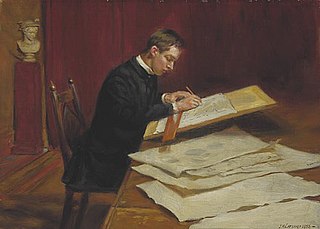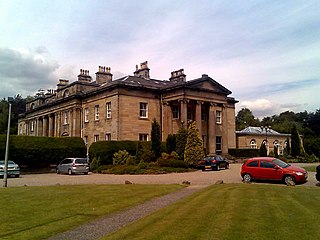
The Hill of Tarvit is a 20th-century mansion house and gardens in Fife, Scotland. They were designed by Sir Robert Lorimer and are today owned by the National Trust for Scotland.

The Hill of Tarvit is a 20th-century mansion house and gardens in Fife, Scotland. They were designed by Sir Robert Lorimer and are today owned by the National Trust for Scotland.

The house is situated on a hillside a mile and a half south of Cupar, Fife. It is set in 40 acres (160,000 m2) of garden and 279 acres (1.13 km2) of open estate. [1] This includes woodland, parkland, farmland and open heath, with extensive views. [2]

Between 1905 and 1906, the house and gardens were remodelled, for the Sharp family, by the renowned Scottish architect Sir Robert Lorimer incorporating French and Chippendale-style furniture, porcelain and paintings collected by F B Sharp. [2]
The house today and wider estates are owned and operated by the National Trust for Scotland. They display Lorimer's original design and furnishings, and they are open to the public. [2] Visitors are able to see both the Sharp family's state of the art accommodation, as well as glimpse life "below-stairs" for the servants. The 9-hole golf course has also been restored and players can compete in Edwardian style with original hickory clubs and softer rubber-wound balls.
The site dates back to at least the Iron Age. The remains of a homestead were excavated in 1946–1947 at the top of Tarvit Hill. During the excavation, an elaborate circular wooden house of about 17 m in diameter was found, it was within an oval bank which enclosed an area of 33x27m. The house is thought to have been occupied between 200 BC and AD 200, and rebuilt at least twice in that period. [1]

In 1500, Scotstarvit Tower was built a mile southwest from Hill of Tarvit. This was constructed by the Inglis family of Tarvit as the centre of their estate. The tower was then sold in 1611 to Sir John Scott of Scotstarvit. Sir John rebuilt much of the tower in the 1620s – seen by the date 1627 on a piece of the Tower's chimneypiece that now forms part of the fireplace in the Hill of Tarvit's smoking room. [1]
The estate, then known as Unthank was remodelled by John Wemyss of Unthank after 1696. Wemyss neglected the defensive tower as redundant and built a new mansion house on the site of the current Hill of Tarvit house, naming it "Wemyss House". The architect used here was possibly Sir William Bruce. This house was expanded in the following centuries, with a service wings added to the rear or north side, one during the 1840s. [1] It was extensively rebuilt in 1907 by Robert Lorimer. [3]


Frederick Bower Sharp purchased Wemyss Hall and its then 1,223-acre (4.95 km2) estate in 1904. Sharp's family had made their fortune in Dundee's jute industry as mill owners (and had sold cloth for sandbags to both sides during the American Civil War [4] ), and Sharp had added venture capital and rail transport to his business interests (he was chairman of the London, Midland and Scottish Railway [4] ). His intention was to construct a new family home with ready access to Dundee and to his golfing interests at St Andrews' Royal and Ancient Golf Club. [1] He also wanted somewhere to house his already extensive collection of paintings, tapestries, furniture and porcelain. Although the location of Wemyss Hall met his requirements, the accommodation did not, and so he engaged the architect Sir Robert Lorimer. Lorimer had recently transformed Kellie Castle, just ten miles (16 km) away. [4] Over the next two years, the new mansion house (named Hill of Tarvit) replaced the main block of the earlier house, although the rear service wings were retained. The new house was fitted with all modern conveniences, including electricity, an internal phone system and central heating. Sharp added a 9-hole golf course in 1924 to the south of the house. [1]
Beatrice White, Frederick's wife, was born in 1864 at Castle Huntly in Longforgan, the fifth child of James Farquhar White, who had amassed a fortune trading with America in jute, linen and other 'dry goods'. [5] She married Fred in 1896 - her older sister, Eleanor having married Fred's oldest brother, John Sharp in 1886. Beatrice's oldest brother was the liberal MP, J Martin White, who with his father had installed electricity at their house, Balruddery, in 1881, possibly the first house in Scotland and second in Britain after Cragside to have a domestic electrical generating plant [6] (though Lord Kelvin at Largs had installed electricity earlier using batteries). Beatrice was thus well-equipped to partner Frederick in the modernisation of Hill of Tarvit and her house-keeping and hospitality were always considered exemplary.
Hugh Sharp (born 1897), Frederick and Beatrice's first child and only son, inherited the house on his father's death in 1932. Hugh, who had served with distinction during the 1914–18 war, added to the house's collection, his particular interests being rare books, and botanical specimens (many of which can still be seen in the gardens). In 1937, Hugh was travelling by rail to meet his fiancée Mabel Hogarth in Glasgow. He was one of 35 people killed when the Glasgow-Edinburgh express collided with a stationary train at Castlecary. [1] (See Castlecary rail accidents.) His mother Beatrice continued to live at Hill of Tarvit until her death in 1946. Two years later, on the death of his sister Elizabeth (born 1909), the house and the family's collection was left to the National Trust for Scotland, with a sizable endowment for upkeep. Hugh's book collection was presented to the National Library of Scotland. [1]
Until 1977, only the ground floor of the house was open to the public, and then only by appointment, the upper floors being used by the Marie Curie Foundation as a convalescent home. [1] The fireplace which is situated in the billiard room originated in Scots Tarvit Tower. The monument at the top of Tarvit Hill was once the mercat cross in Cupar, which was won as a bet in a game a cards.

Fife is a council area, historic county, registration county and lieutenancy area of Scotland. It is situated between the Firth of Tay and the Firth of Forth, with inland boundaries with Perth and Kinross and Clackmannanshire. By custom it is widely held to have been one of the major Pictish kingdoms, known as Fib, and is still commonly known as the Kingdom of Fife within Scotland. A person from Fife is known as a Fifer. In older documents the county was very occasionally known by the anglicisation Fifeshire.
Cupar is a town, former royal burgh and parish in Fife, Scotland. It lies between Dundee and Glenrothes. According to a 2011 population estimate, Cupar had a population around 9,000, making it the ninth-largest settlement in Fife, and the civil parish a population of 11,183. It is the historic county town of Fife, although the council now sits at Glenrothes.

Ceres is a village in Fife, Scotland, located in a small glen approximately 2 miles (3 km) over the Ceres Moor from Cupar and 7 mi (11 km) from St Andrews. The former parish of that name included the settlements of Baldinnie, Chance Inn, Craigrothie, Pitscottie and Tarvit Mill.

Knightshayes Court is a Victorian country house near Tiverton, Devon, England, designed by William Burges for the Heathcoat-Amory family. Nikolaus Pevsner describes it as "an eloquent expression of High Victorian ideals in a country house of moderate size." The house is Grade I listed. The gardens are Grade II* listed in the National Register of Historic Parks and Gardens.

Sir Robert Stodart Lorimer, KBE was a prolific Scottish architect and furniture designer noted for his sensitive restorations of historic houses and castles, for new work in Scots Baronial and Gothic Revival styles, and for promotion of the Arts and Crafts movement.

Kellie Castle is a castle just outside Arncroach and below the dominant hill in the area, Kellie Law. it is about 4 kilometres north of Pittenweem in the East Neuk of Fife, Scotland.

The Grange is an affluent suburb of Edinburgh, just south of the city centre, with Morningside and Greenhill to the west, Newington to the east, The Meadows park and Marchmont to the north, and Blackford Hill to the south. It is a conservation area characterised by large early Victorian stone-built villas and mansions, often with very large gardens. The Grange was built mainly between 1830 and 1890, and the area represented the idealisation of country living within an urban setting.

The Palace of Monimail, also known as Monimail Tower, was a Renaissance palace in Fife, Scotland. A residence of the Archbishops of St Andrews from the 13th century, in the early 17th century Monimail became a chief seat of the Melville family. Lord Monimail is one of the subsidiary titles of the Leslie-Melville Earls of Leven. It was abandoned in the late 17th century and subsequently most of the palace was demolished. One tower remains standing in the grounds of Melville House near the village of Monimail, 4 kilometres (2.5 mi) north of Ladybank.

John Henry Lorimer was a Scottish painter who worked on portraits and genre scenes of everyday life.
Sir John Scot, Lord Scotstarvit (1585–1670), was a Scottish laird, advocate, judge, politician and author. He was Director of Chancery and a Lord of Session. His surname is often spelt as Scott, and Scotstarvit is also spelt as Scotstarvet or Scotstarver.

Balcaskie is a 17th-century country house in Fife, Scotland. It lies around 2 km north of St Monans, and is notable chiefly as the home and early work of architect Sir William Bruce.

Scotstarvit Tower is a tower house in Fife, Scotland. It is situated 2 miles (3.2 km) south of Cupar, between Tarvit Hill and Walton Hill, south of the River Eden, and west of the A916 road.

Pittencrieff Park is a public park in Dunfermline, Fife, Scotland. It was purchased in 1902 by Andrew Carnegie, and given to the people of Dunfermline in a ceremony the following year. Its lands include the historically significant and topologically rugged glen which interrupts the centre of Dunfermline and, accordingly, part of the intention of the purchase was to carry out civic development of the area in a way which also respected its heritage. The project notably attracted the attention of the urban planner and educationalist, Patrick Geddes.

West Wemyss is a village lying on the north shore of the Firth of Forth, in Fife, Scotland. According to the 2007 population estimate, the village has a population of 237. The village was granted burgh of barony status in 1525, bearing the name from the Wemyss family who lived in Wemyss Castle.

Balbirnie House is an early 19th-century country house in Glenrothes, in central Fife, Scotland. The present house was completed in 1817 as a rebuild of an 18th-century building, itself a replacement for a 17th-century dwelling. The home of the Balfour family from 1640, the house was sold in 1969 and opened as a hotel in 1990. The grounds now comprise a large public park and a golf course. The house is protected as a category A listed building, while the grounds are included in the Inventory of Gardens and Designed Landscapes in Scotland.

Raith, as an area of Fife, once stretched from the lands of Little Raith, south of Loch Gelly, as far as Kirkcaldy and the Battle of Raith was once theorised to have been fought here in 596 AD. Raith Hill, west of Auchtertool and immediately to the east of the Mossmorran fractionation plant, may also be in reference to this wider area or may refer to an actual fort on this hill, distinct to the one naming the area.

Amisfield House was a substantial Palladian mansion near Haddington, East Lothian.